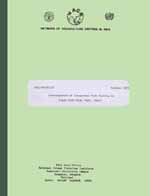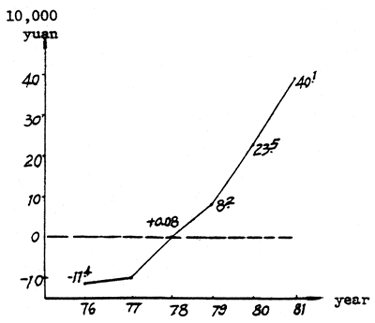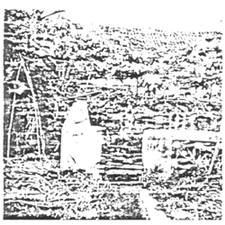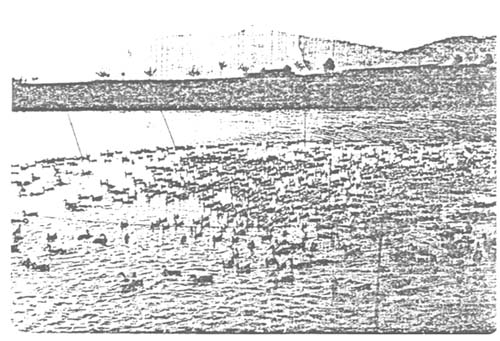
| NACA/WP/83/10 | October 1983 |
 |
Investigation of Integrated Fish Farming in Holei Fish Farm, Wuxi, China |
Research Section
Regional Lead Centre in China
NETWORK OF AQUACULTURE CENTRES IN ASIA
Bangkok, Thailand
October 1983
Hyperlinks to non-FAO Internet sites do not imply any official endorsement of or responsibility for the opinions, ideas, data or products presented at these locations, or guarantee the validity of the information provided. The sole purpose of links to non-FAO sites is to indicate further information available on related topics.
This electronic document has been scanned using optical character recognition (OCR) software. FAO declines all responsibility for any discrepancies that may exist between the present document and its original printed version.
Research Section
Regional Lead Centre in China
A special aspect of freshwater aquaculture in China is integrated fish farming, a significant component of the country's ecological agriculture. Practices show that within the integrated farming approach there are considerable reductions in costs for feeds and organic fertilizer, thereby increasing a farm's overall profit margin. Fish are not only produced but also agricultural and side-line products like crop, livestock, poultry, century (processed) eggs, silk, etc.
Holei Fish Farm is an excellent model of this farming pattern. The average fish yield in 1981 was greater than 7500 kg/ha. The farm has a pond area of 77 ha producing 500,000 kg of live fish for commerce yearly. It has the best average fish production per unit pond area of all farms in Wuxi. Farm products including livestock, poultry, fish, eggs, and milk are provided to the markets throughout the year. In addition, the annual per capita income has increased to 1056 yuan*, the average in Wuxi City being ¥ 600. Therefore, integrated fish farming practices provide high social and economic benefits. This survey and others are being made to summarize the experience of integrated farming in China.
Holei Fish Farm was created in 1975 on an unused field adjacent to Taihu Lake. The history of the farm's increasing production since then is typical for the development progress of integrated farms in the Wuxi area.
At the outset of operation in 1976, a limited number and kinds of livestock and poultry were farmed with a total production equaling 11% of that produced in 1981. Fish feeds were insufficient, and an average of 675 kg/ha of fish were produced in 1976 or 8.7% of that for 1981. In 1977 fish yield increased to 1500 kg/ha or 20% of that in 1981. For 1976 and 1977, there was a total operation deficit of ¥ 213,000 due to the costs associated with the large amount of feeds purchased from outside the farm.
In 1978, efforts were made to increase the level of integrated farming practices by rearing pigs constructed on the pond dikes, raising cows in sheds built adjacent to the ponds, cultivating ducks on the ponds, and feeding fish with manure and other wastes from these animals. Consequently, the fish output was doubled that year, and profit was generated by the farm for the first time. At present, in addition to the 77 ha of fish pond area, the farm has a dairy heard of 100 cows, pigsties housing 1000 pigs, ducks producing thousands of eggs daily, more than 4 ha of water area for water hyacinth cultivation, preserved egg mill, and a number of other product industries. The 3.3 ha of pond dike area is used for green fodder and soybean cultivation. There is also a shop on the premises for aquatic products sales, and a tourist hostel.
A huge quantity of fish feeds and manures can now be obtained on the farm. In 1981, 18 x 106 kg of manure were produced within the farm. An average of 1,167 kg were applied to each hectare of pond area making the farm self-reliant on its manure needs. Otherwise ¥100,000 would have been required for the purchase and transport of these manure needs, reducing the per hectare costs by ¥1455 or ¥8 per 50 kg of fish. Since 1978, the fish output for the market has increased annually by an average of 78.8%. Commercial fish produced in 1981 was 5.2 times that of 1977 (Fig. 1), and the profit margin increased as well (Fig.2). The economic and production achievements of Holei Fish Farm in 1981 are as follows:
The total net commercial fish production was 600,000 kg with an average of 7771.5 kg/ha.
The total animal products equaled 1,090,000 kg, 4.5 times that of 1977. Of this total, 490,000 kg were from livestock and poultry. On the average, 5023 kg of animal products were contributed from the equivalent of 217 fulltime workers. There were 280 farm workers of whom some worked part-time in the farming sector and part-time in the sideline industries and commerce.
The total output value for the entire farm staff was ¥3,190,000 of which fishery accounted for ¥1,140,000, livestock for ¥1,020,000, and industry and commerce for ¥1,030,000. The average output value per capita was ¥11,400.
The net profit was ¥400,000 with an average net profit per capita of ¥1,400.
The year's average income per worker was ¥1,056.23, 2.25 times higher than that for 1977. The fish output at the end of September 1982 was 10% higher than the same period in 1981. This fish farm is now one of the principal producers of animal protein for Wuxi, sending fish, pork, milk, and eggs to the market daily.

Figure 1. Output Increases of Fish, Livestock and Poultry at Holei Fish Farm

Figure 2. Curve of Net Profit at Holei Fish Farm

Figure 3. Integrated Activities at Holei Fish Farm
NOTE: The dotted line refers to the activities outside the fish farm.
Holei Fish Farm demonstrates five types of integration: (a) fish and agriculture, (b) fish and pigs, (c) fish and cows, (d) fish and ducks, and (e) fish farming with wastes from industry. The forms of integration have been created on the basis of available resources and efficient energy use within the farm. There are also five integrated fish farming systems based on the sequential production procedures as follows:
An agriculture-fish integrated system uses pond mud, animal manure, and nightsoil as fertilizer for the cultivation of English rye grass and Sudan grass on pond dikes which in turn are used as fish feeds.
A water hyacinth-pig-fish system cultivates water hyacinth as pig feed. The pig manure is then used to fertilize fish ponds.
A water hyacinth-duck-fish farming system is similar to the method indicated in 2. above but substituting the pigs with ducks. In addition, waste duck feeds are also put into the ponds, and eggs are produced as well as meat.
A fish-cow system uses both the cow dung and wasted cow feeds including grasses as nutrient inputs for the fish ponds.
An example of a system of industry, commerce and fish culture at Holei Fish Farm is one of using silkworm pupae and wastewater from silkworm cocoon processing as fish food and nutrients for fish pond respectively.
In all of the systems, fish farming is the main activity. Aquaculture forms the central core of the overall strategy. Most resources flow through it from one activity to another forming a network (see Fig.3). A network of this kind constitutes a semi-artificial system of ecological balance, conserving nutrient and energy resources. The material wastes from fish, livestock, poultry and crop cultivation are efficiently cycled as resources for each other. This is true as well for the use of land and water areas and sunlight which are optimally utilized for maximum production with minimum costs.
Beneficial economic results have been achieved through the integration of agriculture, animal husbandry and fisheries as practised at Holei Fish Farm.
1. Significance of Water Hyacinth Cultivation to Animal Rearing
To explore the use of water hyacinth, this farm used an adjacent marginal 4 ha water area of Taihu Lake for its cultivation. From this area more than 1200 tons of plant material are produced each year providing enough feed for 2200 ducks and 1050 porkers for 6 months. The production costs are only ¥ 1200 saving ¥8300 if an equivalent of green fodder is purchased from outside the farm. Moreover, water hyacinths are more nutritious than other green feeds available to the farm as shown in Table 1. In addition, 200 kg of fish can be captured from the area where the water hyacinth is grown each year, providing an extra income of ¥2000.
Table 1 Comparison of the nutrients in water hyacinth and green vegetable (Brassica chinensis) in %
| Item | Coarse Protein | Carbohydrates | Coarse Fat |
| Water hyacinth | 1.9 | 2.21 | 0.25 |
| Green vegetables | 1.1 | 2.0 | 0.1 |
2. Fish-cum-Pig Integration and Economic Benefits
Since 1979, there were between 1,100 to 1,300 pigs reared annually in Holei Fish Farm or 15 pigs/ha of fish pond area. In 1981, there were over 1,300 pigs with a total weight of 83,000 kg, including thirty-five sows. The fattening pigs can reach a body weight of 60 to 75 kg in six to eight months. Each fattening pig can produce between 2,000–2,350 kg of manure per year, and a sow yields 4,500 kg per year. All the pig sties are constructed on the pond dikes. The pig sties are washed with water once each day, diluting the manure about 1–2 times. The pig manure from the collection pit is spread uniformly over the surface of the fish ponds once per day or every other day. The manure from 15–30 pigs/ha is far less than that needed for one hectare of pond area, therein eliminating concern for degradation of water quality to a degree where fish are stressed. The water fertility is commonly regulated through controlling the supplement inputs of duck and cow manures and other feeds.
Pig manure is the main source of fertilizer for pond fish culture in China. It is reported that its carbon to nitrogen ratio is 14.3:1 which makes this kind of manure decompose rapidly. As a result, the pig manure promotes the growth of plankton, a good nutrient source for plankton-feeding fishes.
The result of an experiment done by RLCC in 1982 shows that the biomass of phytoplankton in pig manured tanks is 47.8% higher than in one not receiving manure. Accordingly, the experiment demonstrated that the output of silver carp was 32.8 times higher in the manured tank partly due to this fish's capacity to consume undigested nutrients in the pig manure.
Impressive economic benefits have been achieved from the integration of fish with pigs on this farm. About 25 kg of fresh pig manure can produce 0.5 kg of fish. One fattening pig can produce enough manure to yield 40 to 50 kg of fish. At present, there are 1,050 pigs reared at the farm. As a result, over ¥30,000 have been saved in otherwise needed manure purchased from outside the farm plus 6000 kg of fuel for its transport. Pig rearing has also provided employment for twelve people giving each an annual average income of over ¥1,000.
3. Fish-cum-Cow Integration and Economic Benefits
On the farm in 1981, there were 101 Black and White cows of which 56 were adults. On the average, 1.35 cows produce enough manure for one hectare of fish pond area. The manure discharge amount for a cow varies with its age, feeds and other factors. One adult cow on the farm renders about 35–40 kg of manure and 25 kg of urine on the average each day. Young and growing cows will produce more as compared to that for adults. Therefore, 1,650,000 kg of manure can be rendered from the 101 cows per year. Cow manure is finer than pig manure due to the function of the cow's rumen. The sinking speed of cow manure in water is 2.6 cm/minute. Pig manure sinks at the rate of 4.3 cm/minute. In addition, the suspended origanic detritus of cow manure is 5.7% higher than that of pig manure, but cow manure is less affective for the culture of fish species more dependent upon plankton as feeds such as bighead and silver carps. Also, the pond water quality is higher when cow manure is applied, for there is a smaller quantity of resultant sediment which through decomposition produces stressful water quality conditions for the fish. The average dissolved oxygen content in the cow-manured tank (2.5 mg/l) was higher than the pig-manured tank (1.9 mg/l). In this farm, cow manure is the main source of additional manure used to adjust pond water fertility. Cow manure is applied once every 7–10 days at the rate of 1350 kg/ha.
Improved economic benefits have resulted from the integration of fish and cow. About 20 kg of cow manure or 100 kg of urine produces 0.5 kg of fish. Each year, feed wastes from one cow amount to about 4000 kg of fresh grass which can be used to produce 80 kg of grass carp and Wuchang fish and 40 kg of silver and bighead carps as well. In addition, over 4000 kg of silk are produced by one cow each year. The farm also gains over 500 kg of fish from each cow's wastes. In 1981, the cow farming section alone increase the farm's net profit by ¥36,000 and saved ¥21,000 from the purchase of otherwise needed manure from outside including 4500 kg of fuel required to transport it, and also provided employment for 19 people each with an income of over ¥1000/year.
4. Fish-cum-Duck Integrated Systems
In 1981, there were 22,000 Shaoxin and Khaki-Campbell ducks on this farm. One way to integrate fish with duck is to rear the ducks in coops near the fish ponds (Photograph 1). Everyday the duck manure and their wasted feeds are washed into an adjacent pool and then transferred to the fish ponds by pumping. Another way to rear ducks is over the fish pond (Photograph 2). The duck coops are set up on the pond dikes, and the ducks can move freely onto the fish ponds.
It is very important to know how much manure one duck discharges since it is the main factor in deciding the number of ducks to be reared over a specific pond area. Generally, one cross-bred duck can produce 50 kg of manure each year. Therefore, 3000 ducks are enough for one hectare of fish pond. Experience on this farm has shown that fish production will be decreased if the number of ducks per hectare exceeds 6000 because the pond water becomes too fertile for the fish resulting in the need for aeration and water exchange through pumping which are costly to implement. Polyculture of eight fish species is commonly practiced in this farm. Integration of fish with duck has not specifically affected the decision of the species stocked, their density, or their ratio. However, the stocking density of silver carp, bighead carp, and tilapia should be increased if ducks are reared at the rate of over 3,000/ha.
 |  |
| Photograph 1 | Photograph 2 |
The integration of fish and duck enables the farm to get the best economic benefits as compared to other animal production activities, for ducks have a high egg-laying rate which adds significantly to the income. The following reasons also contribute to the benefits of duck rearing with fish:
Fish can utilize the food wasted by ducks through integration. Generally, on a daily basis 10–20% of duck feed is wasted due to their feeding habits. Each duck wastes about 23–30 g of rice and wheat brans per day. All of the wasted feed is collected and fed to fish.
Duck manure in ponds serves directly as a food for fish and fertilizer for plankton consumed by fish. The alimentary canal of a duck is about 4.5 times longer than its body length, resulting in 34% of the feed intake undigested. Duck manure contains 26.2% organic matter which is the highest of the manures put into the fish ponds on this farm. Fish culturists have found that herbivorous and omnivorous fishes prefer to live near the place where duck manure is applied. Duck manure contains N.P2O5.K2O which is 3–5, 1.5–2.2 and 2.6–3 times higher than that of human wastes, respectively. As a result, the total growth contribution from ducks, stocked at the rate of about 1875/ha in the Holei Fish Farm, is 7% for grass carp, 23–35% for crucian carp, and 19–35% for silver and bighead carps in comparison to a control pond under otherwise normal management conditions without ducks.
Ducks reared in the pond eat dead fish, substances from diseased fish, and other harmful organisms. At the same time, fish also consume parasites and skin flakes from ducks so that fish and ducks help control diseases for each other. The integration of fish and ducks further helps release nutrients into the pond water for the fish through stirring the bottom sediments when diving for sunken feeds.
Compared with the control pond, the integration of fish and ducks, at the rate of 1830–1920 ducks per hectare of pond area, saved 20,000 kg of compost otherwise put into the fish ponds, and increased fish yield by 17–32%. In 1981, duck farming produced 100,000 kg of manure and wasted duck feed for fish, 212,500 kg of eggs, and 6,000 kg of duck meat for the markets. In order to get more profit, the farm itself processes duck eggs into preserved and salted ones. In 1981, 1,800,000 preserved eggs and 600,000 salted eggs were produced and sold. Through the egg preserving and salting process, the eggs become more resistant to breakage, reducing loss during transport by 5% or ¥0.30 per 50 kg, and the income per egg increased by ¥0.03. The total income from egg processing was ¥6606.45 per capita and the returned profit rate after costs was 29.2% which was the highest on the farm. The total net profit of the duck farm and egg processing factory in 1981 was ¥137,000 or 36% of that for the whole farm. The activities related to duck rearing improved fish production and provided employment for 60 people.
Integrated fish farming in China has proved to be an effective way to produce and supply products of livestock and poultry to the market.
Protein ration in diets is still relatively low in the developing countries. It is commonly desired to develop freshwater fisheries for the purpose of improving people's diets, but there is a shortage of funds, energy, and food in particular. The population of the developing countries occupies 70% while the grain output was less than 50% of the world's totals. This is why 430 million people are still suffering from hunger. Therefore, it is unreasonable to use a lot of grain for fish farming. Integrated fish farming as demonstrated by Holei Fish Farm is an alternative method whereby all available resources are optimally utilized. This form of farming conserves energy and helps to maintain balanced ecological systems for food production. In addition, it can provide a number of ways to produce and cycle manures and reduce production costs. Farmers can also increase their profits, with the development of integrated farming of fish, livestock and crop, failure of any of the farmed commodities will not adversely damage the livelihood of a farmer.
With the principles of integrated fish farming, Holei Fish Farm has made up deficits and increased surpluses. Accordingly, the income of the farms has been increased greatly. Now the farmers enjoy the same welfare as the factory workers in the cities, and the average income of the farmers is presently higher than that of the city workers. Integrated fish farming can create additional employment opportunities in rural areas and enable farmers to improve their living standards. Now nearly every family in Holei Fish Farm has a new house and a television set.
Integrated fish farming is a means to promote modernization of agriculture. Through the inherent methods in these production practices, the farms have increased their overall effeciency. These strategies can make it possible to reduce the gaps between the urban workers and peasants, cities and countryside.
